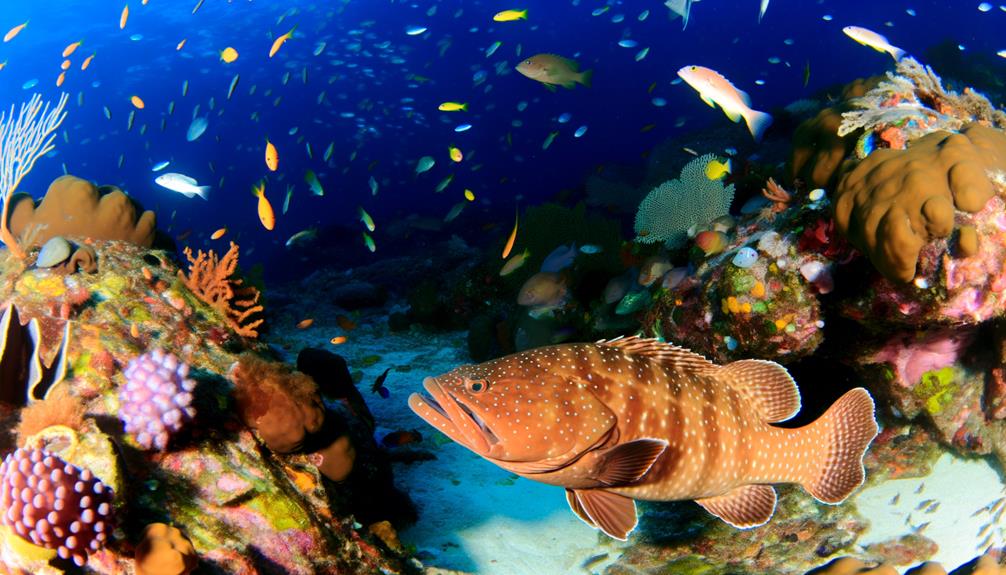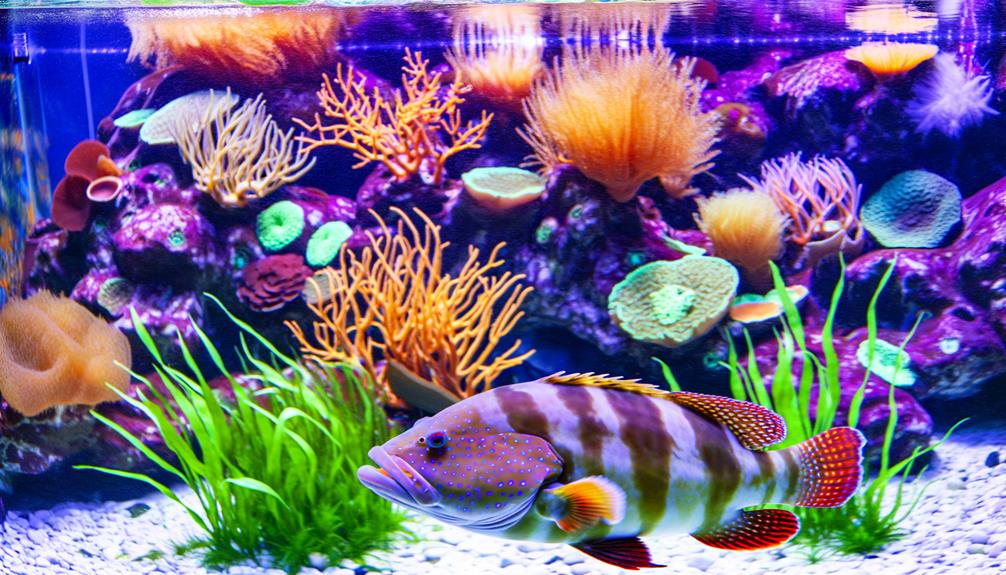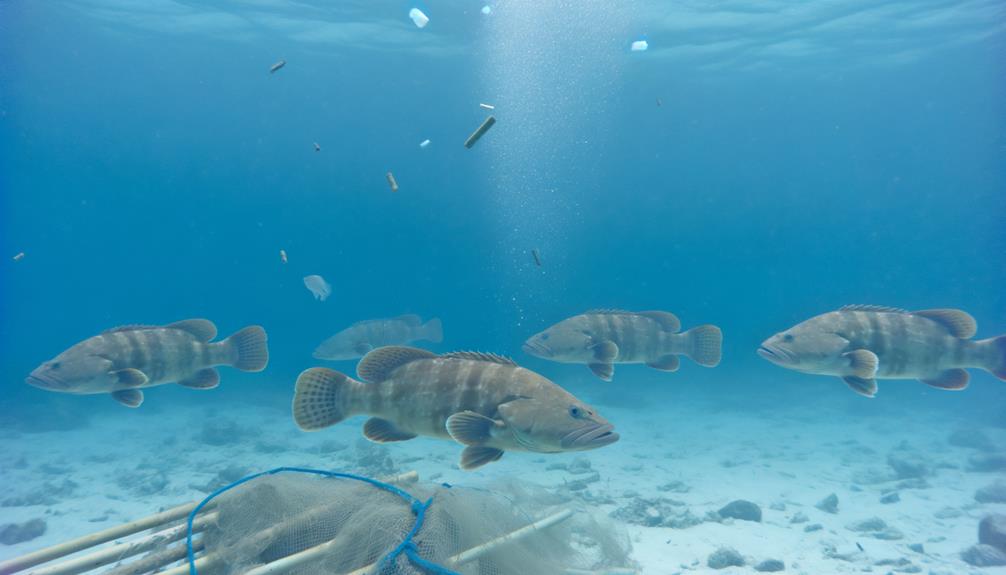The Grouper, renowned for its vibrant beauty and distinct species variation, is indeed a marine dweller. However, the question remains, what is it about the saltwater environment that these fish find so hospitable?
How does their biology adapt to such conditions? And importantly, what are the implications for those who wish to include them in their aquatic collections?
As we explore the fascinating world of Groupers, we invite you to join this engaging discourse on their biological needs, adaptability, and the potential challenges in maintaining them in aquarium settings.
Key Takeaways
- Groupers are indeed saltwater fish, thriving in warm, tropical marine environments.
- They inhabit varied saltwater habitats, from shallow coastal areas to deep sea floors.
- Over 160 recognized grouper species exist, all adapted to diverse saltwater conditions.
- Coral reefs, mangrove forests, and rocky bottoms are essential to grouper's survival.
Understanding Grouper's Habitat
Delving into the realm of Groupers' habitat unveils their strong affinity for predominantly marine environments, a characteristic largely attributed to their saltwater origins. These aquatic beings, including the Louti Grouper, thrive in saltwater, which provides not only sustenance but also the ideal conditions for survival and propagation. The rich biodiversity of these marine environments offers an abundance of food resources, allowing Groupers to sustain their carnivorous diet.
Groupers' habitats vary from the shallow coastal areas to the deep, mysterious ocean floors, providing a testament to their adaptability. This range includes tropical and subtropical waters, where coral reefs and rocky bottoms are abundant. These structures serve as crucial hiding places for Groupers, allowing them to evade predators and ambush prey effectively.
Mangrove habitats also play a significant role in the life of Groupers, providing a safe haven and a nursery for the juveniles. These habitats, teeming with smaller fish, crustaceans, and mollusks, make a perfect hunting ground for these carnivorous creatures. Analyzing these habitats, we can conclude that the Groupers' existence is intricately woven into the fabric of these saltwater ecosystems, underlining their importance in preserving marine biodiversity.
Grouper's Saltwater Origins
The origin of groupers in saltwater can be attributed to their preference for warm, tropical marine environments, which is a critical aspect of their oceanic habitat.
The Serranidae family, to which groupers belong, comprises a multitude of species that exhibit a wide array of sizes, colors, and specific saltwater habitats.
A detailed analysis of their dietary habits will further elucidate the inherent characteristics of groupers as quintessential saltwater dwellers.
Grouper's Oceanic Habitat
Inhabiting tropical and subtropical saltwater environments across the globe, groupers display a preference for coral reefs, rocky areas, and mangrove forests, demonstrating their adaptability to diverse oceanic habitats. This adaptability makes them a popular choice for saltwater aquarium enthusiasts.
Their widespread distribution includes the Atlantic, Pacific, and Indian Oceans, and they are known to dwell both in deeper waters and shallower coastal regions. As carnivorous predators, groupers' diet relies heavily on marine life, similar to the Marine Betta. Their predation contributes to the dynamic biodiversity of marine ecosystems, playing a similar role to smaller marine creatures such as hermit crabs.
Understanding the grouper's oceanic habitat is key to appreciating their role in maintaining the delicate balance of saltwater ecosystems.
Species of Saltwater Groupers
Building upon our understanding of the grouper's habitat, it becomes pertinent to examine the various species of these saltwater predators, each distinguished by unique characteristics, sizes, and dietary preferences.
- The Goliath grouper, also known as the 'Atlantic goliath grouper,' can grow up to 8 feet in length and become aggressive when defending its territory.
- The Nassau grouper, a smaller species, is renowned for its vibrant colors and distinct patterns.
- The Black grouper, another popular species, plays a vital role in maintaining the balance in its marine ecosystem due to its predatory nature.
These species, among others, underline the diversity and ecological significance of the grouper family within saltwater environments. They also exemplify the allure that captivates saltwater aquarium enthusiasts worldwide.
Diet of Saltwater Groupers
Diving into the dietary habits of saltwater groupers, one finds a carnivorous inclination towards fish, crustaceans, and cephalopods, reflecting their predatory nature and saltwater origins. Their feeding habits require a varied diet to meet their nutritional requirements and health monitoring. This rigorous attention to diet maintenance is essential for their well-being.
| Feeding Habits | Nutritional Requirements | Health Monitoring |
|---|---|---|
| Carnivorous (fish, crustaceans, cephalopods) | Varied diet | Regular feeding behavior observation |
| 2-4 times weekly | Appropriate portion sizes | Prompt response to issues |
| Predatory nature | Saltwater origin sustenance | Marine aquarium setup |
| Essential for well-being | Prevents health issues | Integral for survival |
This table summarizes the intricate relationship between their feeding habits, nutritional requirements, and the crucial role of health monitoring in maintaining their survival in a saltwater environment.
Different Types of Grouper
Variety is a distinguishing feature in the grouper species, with multiple types such as the Red Grouper, Black Grouper, Gag Grouper, and Goliath Grouper populating different geographic locales and habitats.
Each species exhibits unique characteristics, with variations in size, strength, feeding behavior, and role in the marine ecosystem.
In order to fully understand the impact and importance of groupers in their saltwater environments, a thorough examination of these diverse species is essential.
Grouper Species Diversity
While there is a vast array of fish species in tropical and subtropical waters, the grouper family is notably diverse, boasting over 160 recognized species that range in size and distinctive color patterns. This diversity influences grouper behavior, grouper reproduction, and grouper conservation efforts.
- Grouper Behavior: Known for their camouflage abilities, groupers alter their color patterns to blend seamlessly with their surroundings for hunting and protection.
- Grouper Reproduction: Species size greatly influences reproductive habits, smaller species like the Fairy Basslet Grouper reproduce differently than larger variants like the Goliath Grouper.
- Grouper Conservation: The species' diversity necessitates targeted conservation efforts, as threats and vulnerabilities vary among different groupers. This diversity binds us collectively in our responsibility for their preservation.
Unique Grouper Characteristics
Exploring the unique characteristics of various grouper species reveals a fascinating blend of diversity, with each type boasting distinctive appearances, engaging behaviors, and specific dietary needs. Their color variations alone, from the Panther Grouper's distinctive black and white markings to the Blue Dot Grouper's vibrant spots, showcase the rich biodiversity within the species.
Groupers' social behavior can be observed in their interactions within their marine environment, where they can exhibit territorial tendencies. Their carnivorous dietary habits include consuming fish, crustaceans, and cephalopods.
Breeding habits vary among grouper species, and some are known to change sex during their lifespan. It is this complexity of groupers that contributes to their allure, making them an intriguing subject for marine enthusiasts and scientists alike.
Role of Groupers in the Ecosystem

In the intricate web of the marine ecosystem, groupers perform a significant role by regulating the population of smaller fish species, thus fostering a balanced and sustainable aquatic environment. Their influence extends beyond mere population control to predator-prey dynamics, where they maintain the ecosystem balance.
- Groupers, as apex predators, help to regulate the number of smaller fish species. Their predatory nature prevents overpopulation and contributes to a healthier marine ecosystem.
- They enhance marine biodiversity and coral reef health. By keeping certain species in check, they allow for a greater variety of organisms to thrive in the same environment, hence increasing biodiversity.
- By maintaining population control, groupers indirectly support sustainable fishing practices. An overabundance of certain species can destabilize the ecosystem and affect the availability of other species targeted by fishermen.
Catching Groupers: Angler's Guide
Having established the essential role of groupers in marine ecosystems, it is equally important to understand the techniques and considerations for anglers who seek to catch these formidable saltwater fish.
Grouper fishing techniques vary based on the size and weight variations of the targeted species. Larger groupers, exceeding 8 feet and 800 pounds in some instances, necessitate stronger gear and resilient angler determination. Challenges often arise in the form of their robust fight, rocky habitat preferences, and the need to respect fishing regulations for sustainable practices.
Understanding grouper spawning behavior and migration patterns can vastly improve the success rate of the angler. Groupers typically spawn in large aggregations, making these periods prime time for fishing. However, this behavior also makes them vulnerable to overfishing, necessitating regulated catch limits during spawning seasons.
Maintaining Groupers in Aquariums

As coveted additions to marine aquariums, groupers, renowned for their vibrant colors and substantial sizes, demand specific care and environmental considerations for their successful maintenance in captivity. Their care involves a comprehensive understanding of their feeding behavior, health, and maintenance requirements, along with the essential knowledge of their breeding habits and potential tankmates.
- Grouper breeding, tankmates: Groupers are best kept singularly to prevent territorial disputes. Their size and aggressive nature make them unsuitable for cohabitation with smaller or less assertive species.
- Grouper feeding, behavior: Groupers are carnivores, requiring a diet rich in fish, crustaceans, and cephalopods. Their feeding schedule should be diverse and routine, with keen observation of their behavior to ensure they are receiving adequate nutrition.
- Grouper health, maintenance: Maintaining optimal water conditions is crucial for their health. The tank size should range between 180 to 300 gallons to accommodate their swimming habits, with hiding spots provided for their comfort. Regular monitoring for signs of marine ich or other diseases is essential to ensure their well-being.
Dietary Patterns of Groupers
Shifting our focus from their environmental needs, a thorough understanding of groupers' dietary patterns is vital due to their carnivorous nature and the role they play as apex predators in the reef ecosystem. Groupers primarily feed on fish, crustaceans, and cephalopods, illustrating their diverse feeding habits. A voracious appetite underlines their nutritional needs, demanding regular feeding to maintain their health and vitality.
Overfeeding, however, can lead to health issues, highlighting the necessity of monitoring their dietary requirements and adjusting portion sizes accordingly. Providing groupers with a varied diet ensures they receive the essential nutrients needed for their well-being.
To provide a more detailed understanding, consider the following table:
| Predatory Nature | Feeding Habits | Nutritional Needs |
|---|---|---|
| Apex Predator | Diverse Diet | Regular Feeding |
| Avoid Overfeeding | Monitor Portions | Varied Diet |
| Health & Vitality | Essential Nutrients | Dietary Requirements |
Thus, a comprehensive understanding of the dietary patterns of groupers is not only necessary for their maintenance but also to ensure the balance of the reef ecosystem in which they thrive.
Threats to Grouper Population

Despite the resilience demonstrated by groupers in their dietary patterns and adaptability, their population faces significant threats on a global scale, primarily driven by human activities such as overfishing and destruction of their natural coral reef habitats.
For instance, the overfishing impacts are severe and widespread, leading to a drastic reduction in grouper numbers. The uncontrolled harvest of these fish for commercial purposes and the use of illegal fishing methods, such as dynamite fishing, have put the survival of many grouper species at risk.
In addition to this, the destruction of coral reefs, which serve as the primary habitat for groupers, has led to a significant loss of their dwelling places and breeding grounds. The degradation of these habitats due to pollution and climate change effects, such as ocean warming and acidification, also pose a considerable threat.
Here's a breakdown of the top three threats to the grouper population:
- Overfishing impacts: High demand for grouper in the seafood industry leads to their over-exploitation.
- Coral reef destruction: Groupers' habitat and breeding grounds are being lost due to human activities and climate change.
- Illegal fishing methods: Deadly practices like dynamite fishing are causing a rapid decline in their numbers.
Hence, it's crucial to consider conservation strategies and habitat restoration measures. Enforcement against illegal practices is also a necessity to ensure the survival and growth of these remarkable fish species.
Grouper Conservation Efforts
Recognizing these threats to the grouper population, concerted efforts are being made to conserve these saltwater fish species and ensure their sustainability. Initiatives include implementing fishing regulations and establishing marine protected areas that safeguard grouper breeding habitats.
Active research is conducted to study grouper population dynamics, with particular attention given to their migration patterns and breeding behaviors. Understanding the timing and routes of grouper migration is critical to design effective conservation strategies. Meanwhile, insights into their breeding, such as the timing and location of spawning aggregations, provide a basis for regulations and protection measures during these vulnerable periods.
Habitat restoration projects further contribute to grouper conservation, reestablishing the underwater structures that are vital for their life cycles. Collaboration among governments, conservation organizations, and local communities is crucial for these efforts, integrating scientific findings with on-the-ground action.
Public awareness campaigns play a crucial role as well. They aim to foster an understanding of the importance of grouper conservation, not just for the species itself, but for the larger marine biodiversity and ecosystem health. Through these multi-pronged efforts, it is hoped to secure a sustainable future for these remarkable saltwater fish.
Frequently Asked Questions
Is Grouper Saltwater or Freshwater?
In exploring Grouper habitat, it's evident that these fish are saltwater dwellers. Their adaptations to marine environments distinguish them from freshwater species. Thus, in the freshwater vs saltwater debate, Groupers unequivocally belong to saltwater habitats.
What Kind of Fish Is Grouper?
Grouper is a robust, carnivorous saltwater fish residing in tropical and subtropical habitats. Known for its large mouth, it feeds on smaller fish, crustaceans, and cephalopods. Its lifespan and diet contribute to its vital role in marine ecosystems.
What Does a Saltwater Grouper Look Like?
Ever wondered how to spot a grouper underwater? Look for its robust body, large mouth, and prominent fins. Grouper's color variations include red, brown, orange and yellow, and some have distinctive patterns or spots.
What Are 3 Fish in Salt Water?
Three notable saltwater fish are groupers, clownfish, and tangs. All play vital roles in maintaining marine ecosystem balance and are common coral reef inhabitants. Knowledge of saltwater fishing techniques aids in their sustainable capture.
Conclusion
In conclusion, groupers, as a saltwater species, play an integral role in marine ecosystems. Their diverse types, dietary patterns, and distinctive habitats make them unique.
Despite the threats they face, conservation efforts have been initiated to preserve their populations. Understanding and maintaining their specific needs in aquariums can foster their well-being.
Their role as a popular catch for anglers further underscores the importance of sustainable fishing practices for their preservation.


